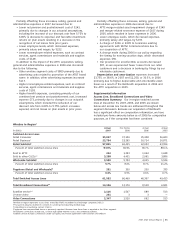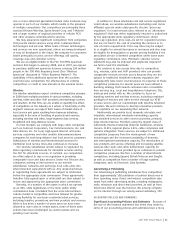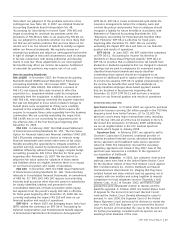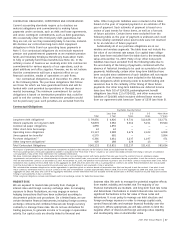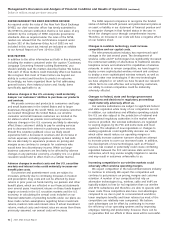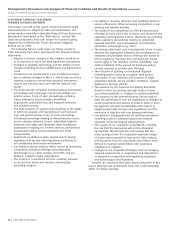AT&T Wireless 2007 Annual Report Download - page 46
Download and view the complete annual report
Please find page 46 of the 2007 AT&T Wireless annual report below. You can navigate through the pages in the report by either clicking on the pages listed below, or by using the keyword search tool below to find specific information within the annual report.
Management’s Discussion and Analysis of Financial Condition and Results of Operations (continued)
Dollars in millions except per share amounts
44
| 2007 AT&T Annual Report
Retiree Phone Concession Litigation In May 2005, we
were served with a purported class action in U.S. District
Court, Western District of Texas (Stoffels v. SBC Communi-
cations Inc.), in which the plaintiffs, who are retirees of
Pacific Bell Telephone Company, Southwestern Bell, and
Ameritech, contend that the telephone concession provided
by the company is, in essence, a “defined benefit plan” within
the meaning of the Employee Retirement Income Security
Act of 1974, as amended (ERISA). On October 3, 2006, the
Court certified two classes. The issue of whether the
concession is an ERISA pension plan was tried before the
judge the week of November 26, 2007. The court has
rendered no decision. We believe that an adverse outcome
having a material effect on our financial statements in this
case is unlikely, but will continue to evaluate the potential
impact of this suit on our financial results as it progresses.
NSA Litigation There are 24 pending lawsuits that allege
that we and other telecommunications carriers unlawfully
provided assistance to the National Security Agency (NSA) in
connection with intelligence activities that were initiated
following the events of September 11, 2001. In the first filed
case, Hepting et al v. AT&T Corp., AT&T Inc. and Does 1-20,
a purported class action filed in U.S. District Court in the
Northern District of California, plaintiffs allege that the
defendants have disclosed and are currently disclosing to
the U.S. Government content and call records concerning
communications to which Plaintiffs were a party. Plaintiffs
seek damages, a declaratory judgment, and injunctive relief
for violations of the First and Fourth Amendments to the
United States Constitution, the Foreign Intelligence Surveil-
lance Act, the Electronic Communications Privacy Act, and
other federal and California statutes. We filed a motion to
dismiss the complaint. The United States asserted the “state
secrets privilege” and related statutory privileges and also
filed a motion asking the court to either dismiss the complaint
or issue a summary judgment in favor of the defendants.
The Court denied the Motions to Dismiss of both parties.
Specifically, the Court ruled that the state secrets privilege
does not prevent AT&T from asserting any statutory defense
it may have, as appropriate, regarding allegations that it
assisted the government in monitoring communication content.
However, with regard to the calling records allegations, the
Court noted that it would not require AT&T to disclose what
relationship, if any, it has with the government. We and the
U.S. government filed interlocutory appeals in July 2006. The
case was argued before a panel of the U.S. Court of Appeals
for the Ninth Circuit on August 15, 2007. We are awaiting a
decision. Management believes these actions are without
merit and intends to vigorously defend these matters.
Prepaid Calling Card Patent Litigation On September
14, 2007, a jury in Texas found that ATTC willfully infringed
two patents owned by TGIP Inc. (TGIP) relating to point-of-
sale prepaid cards sold by ATTC and awarded TGIP $156 in
damages. (TGIP Inc. v. AT&T Corp. et al., U.S. District Court for
the Eastern District of Texas). The jury’s finding of willfulness
also entitled TGIP to ask the judge to award additional
damages up to treble the jury verdict. On September 28,
2007, AT&T filed a motion requesting that the Court overturn
the jury’s verdict as a matter of law. On October 29, 2007, the
Court overturned the jury’s finding of infringement, the jury’s
$156 award of damages and the jury’s finding of willfulness.
TGIP has appealed the Court’s decision and oral argument
on their appeal is likely to be held later in the third quarter
of 2008.
Broadcom Patent Dispute A number of our handsets, as
well as those provided by other wireless carriers, are subject
to a patent dispute at the U.S. International Trade Commission
(ITC) between Broadcom Corporation and Qualcomm Incorpo-
rated (Qualcomm). Currently, the U.S. ITC’s exclusion order
applicable to certain Qualcomm technology is stayed pending
a decision by the appeals court. We anticipate a decision will
not occur before late in the second quarter of 2008. We
continue to take steps to mitigate the effects on us. However,
if no resolution were to occur, future costs and availability of
handsets using Qualcomm chips could be adversely affected.
LIQUIDITY AND CAPITAL RESOURCES
We had $1,970 in cash and cash equivalents available at
December 31, 2007. Cash and cash equivalents included cash
of $889 and money market funds and other cash equivalents
of $1,081. Cash and cash equivalents decreased $448 since
December 31, 2006. During 2007, cash inflow was primarily
provided by cash receipts from operations, the issuance of
long-term debt, net cash received from dispositions of
non-strategic real estate and the sale of marketable securities
and other assets. These inflows were offset by cash used to
meet the needs of the business including, but not limited to,
payment of operating expenses, funding capital expenditures,
repurchase of common shares, the repayment of debt,
dividends to stockholders and payment of interest on debt.
We discuss many of these factors in detail below.
Cash Provided by or Used in Operating Activities
During 2007, cash provided by operating activities was
$34,072 compared to $15,615 in 2006. Operating cash flows
increased primarily due to an increase in operating income
reflecting additional cash provided by the BellSouth
acquisition and our success in achieving merger synergies
and operational efficiencies, partially offset by increased
interest payments of approximately $1,800 and tax payments
of $1,200. During 2007, tax payments were higher due
primarily to a $1,000 deposit related to the IRS examination
of our 2000 – 2002 income tax returns. The timing of cash
payments for income taxes, which is governed by the IRS
and other taxing jurisdictions, will differ from the timing
of recording tax expense and deferred income taxes,
which are reported in accordance with GAAP.
During 2006, our primary source of funds was cash from
operating activities of $15,615 compared to $12,974 in 2005.
Operating cash flows increased primarily due to an increase
in net income of more than $2,500 and additional cash
provided by the ATTC acquisition, partially offset by increased
tax payments of $739 in 2006. Tax payments were higher
primarily due to increased income before income taxes.
Tax payments in 2006, include a refund from the completion
of the ATTC federal income tax audit covering 1997 – 2001.
Cash Used in or Provided by Investing Activities
During 2007, cash used in investing activities consisted of:
• $17,717 in construction and capital expenditures.
• $2,200, net of cash acquired, related to the acquisition
of Dobson, a provider of rural and suburban wireless
communications services.
• $579 for investments in debt and equity securities.



